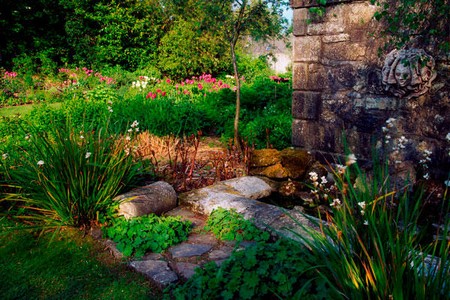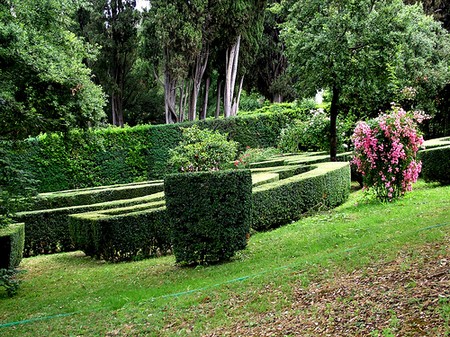THE BASICS
Having a good understanding of why pruning and training are necessary is a major step towards success. What are the aims and objects?
Pruning is carried out:
- to train and maintain shape and form.
- to improve and maintain plant health and prolong life.
- to regulate and sustain cropping and flowering.

Pruning normally has the effect of stimulating growth and is all about the timely cutting out and removal of shoots or parts of shoots or roots. Generally speaking, hard pruning — severe cutting back — of a plant will result in vigorous new growth. This is accompanied, at least in the short term, by some slight delay in flowering and fruiting. Expect fewer but higher quality flowers and fruits to be produced over a longer period with hard pruning. The aim for average purposes should be to steer a middle course when pruning. And it is important that the severity of pruning is not viewed in isolation. It needs to be related to feeding and general management to get a balanced picture.
TIMING
The timing of pruning is important from various viewpoints.
DECIDUOUS TREES AND SHRUBS
In most cases, tree trimming is best done in late summer or autumn. As a rule, spring pruning is best avoided. This is particularly true of deciduous ornamental trees, many of which are severely weakened by being cut at this time of year.
EVERGREENS
Conifers included, these are normally best pruned in late spring or summer. This minimizes the risk of frost or wind injury which can otherwise arise, especially if pruned in winter.
HEDGES
Hedges of all kinds, deciduous and evergreen, are best trimmed in summer or early autumn when the shoots are green, soft and easy to cut. By letting in more air at this time of year the remaining wood is also better able to ripen. This in turn greatly improves the resistance to winter injury. However, it is often more practical to deal with badly neglected deciduous hedges in early winter after leaf fall, when it is easier to see where to make the cuts.
‘SANITATION’ PRUNING
This refers to the cutting out — or shortening back to sound wood — of dead, damaged or badly diseased growths, and is best carried out as soon as possible after discovery, regardless of the time of year, frosty weather excepted. This reduces the risk of further possible disease infection spreading into healthy tissue.
FROSTY WEATHER
Never prune during hard frosts when you risk wood splitting, with the consequential entry of disease.
PRUNING CUTS
The first fundamental rule when making any pruning cut, regardless of size, is that it is clean. There must be no suggestion of jagged edges or tearing. In order to achieve these ends, it is essential that all pruning tools are clean, sharp, well maintained and with all moving parts suitably lubricated.
When pruning back to a bud, start the cut on the opposite side of the stem to the bud and slightly lower down. Then angle the cut so as to make a sloping finish — ending up about 3mm above the top of the bud.
STOPPING/PINCHING
These are the terms variously used to describe the removal of growing points. Plants are normally ‘stopped’ with the intention of encouraging the development of sideshoots and branching below the cut. Take a sharp knife to remove the growing tip and take it out just above a good bud or leaf joint. For the removal of very soft growing points, some old hands prefer to use their thumb nail. But until experience is gained, use a knife — and pruners if the wood is hard.
CLIPPING
Clipping is normally reserved for formal effects — hedges, topiary and bushes included. In this situation, cut back all new growth. Trim to a uniform length and back to within 6 – 12mm of the older wood with shears or hedge trimmer. The result is that secondary shoots break away and a dense texture is created.
HEADING BACK
Heading back (de-horning or crown reduction) involves the shortening back of all the main stems and branches, so reducing the overall height and spread of the crown. Shrubs and trees are often headed back when they have outgrown their allotted space.
Slender shoots of up to 2 cm in thickness are cut back to a healthy outward pointing bud or sideshoot. Thicker branches have their tips shortened back to a strong secondary branch. Avoid shortening back any individual branch by more than one third its length.
THINNING
This is the answer where the crowns of trees and shrubs have been allowed to become overcrowded, or where a more open texture is the aim. In both cases up to one third of the sideshoots and branches are selectively cut out. Each one is taken back to a main branch, stem or bud.
LOPPING
Lopping involves saw work. And when dealing with trees any work above about 2 m (7 ft) is best left to the professionals. Safety harnesses are needed; experience and training required.
However, the removal of old dead or outworn lower branches, up to about 7.5 cm (3 in) in diameter, can reasonably be tackled by the fit and able working from ground level. Branches of up to about 1.8 m (6 ft) in length can be removed intact. Anything longer is best taken out in sections of say about 1.2 m (4 ft) lengths. This reduces the risk of accidents, of wood splitting back into the main framework and of possible damage to underplanting.
To remove a branch, or the final section of a branch, cut about quarter way through the limb on the underside — some 10 cm (4 in) out from the trunk/main stem. Then cut down from the topside about 12.5 cm (5 in) out from the trunk/main stem, completely severing the branch and leaving a short stump. Finally cut off the short stump, flush with the trunk or main stem. Cut down from above and smooth off any rough edges with a sharp knife. Paint over all saw cuts with a proprietary sealant paint to encourage healing and prevent the entry of disease organisms. Undercutting a branch helps to prevent splitting and consequential disease entry.
PRUNING TOOLS
A GOOD PAIR OF HAND PRUNERS/SECATEURS
If clean, sharp and well maintained, there is little to choose between the anvil and side anvil/by-pass models. Most will normally cut wood up to 1 cm hick, and up to 2 cm with heavy duty models. Opt for the best within your budget.
A STRONG, SHARP KNIFE
As very few people have the time, expertise or inclination to sharpen knives, there is much to be said in favour of models which take replacement blades.

A PRUNING SAW
A curved or narrow-bladed pruning saw — one intended to cut green wood — will be needed where anything over 2 cm needs cutting.
A LONG ARM PRUNER
Where there is a fair amount of pruning above about 1.8 m (6 ft) in height, a lightweight alloy, long arm pruner will be found to be indispensable.
GARDEN SHEARS/POWERED HEDGE TRIMMER
In the right hands a good pair of garden shears will cope with up to about a 6 m (20 ft) run of clipped hedge. For greater lengths of hedging, a powered hedge trimmer is invaluable. Before buying an electric hedge trimmer, ensure that the hedge is within easy and safe reach of the mains supply, and always use with a safety power breaker.